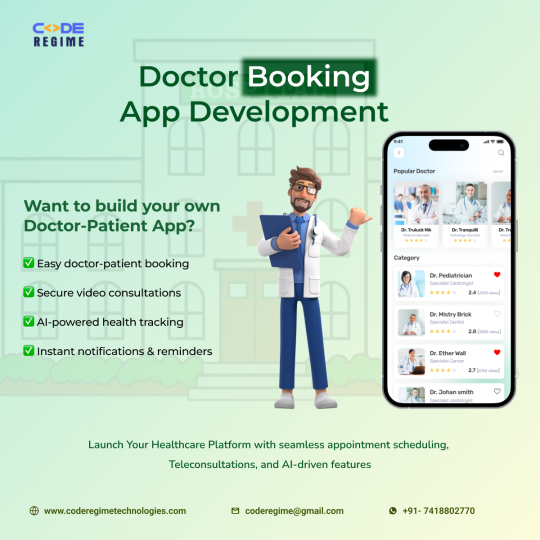#nearshore software development
Explore tagged Tumblr posts
Text

Revolutionize healthcare with our Doctor Appointment App Development Service! Our Expert craft seamless, AI-driven apps that let patients book appointments effortlessly while doctors manage their schedules with ease. Our solutions include telemedicine integration, real-time scheduling, secure patient data management, and automated reminders—ensuring a smooth experience for both patients and practitioners. . . 📌 Get a custom doctor booking app with web & mobile compatibility! 📧 Connect with us at [email protected] for inquiries!
#nearshore software development#software development#mobile app development#custom mobile app development company#business#branding#cloneappdevelopment#healthcareapp#softwaresolutions#appointmentapp#telemedicineapp#pharmacyapp#aiappdevelopmentcompany#datadrivenapp
0 notes
Text

How Do You Implement Data Validation and Error Handling for Your Web Application’s Database Input and Output?
Introduction
In today’s digital economy, businesses rely largely on web applications for client interactions, data management, and day-to-day operations. A web application‘s effectiveness is measured by its functionality and ability to manage data accurately and avoid errors that interrupt corporate processes. Data validation and error management for database input and output are critical to ensuring reliability.
Data validation guarantees that the information entered into your database satisfies the necessary criteria, preventing invalid or damaging data from entering the system. On the other side, error handling focuses on providing tools to deal with difficulties that may arise during database operations, ensuring that the program recovers gracefully.
In this article, we’ll look at how organizations may employ good data validation and error handling in web applications to streamline processes, prevent data corruption, and improve the user experience. We’ll also look at how 8 Tech Labs, a prominent mobile app development firm, can help organizations achieve these goals with competent services.
The Importance of Data Validation and Error Handling
Effective data validation and error handling are vital for any web application that interacts with databases. Without these mechanisms in place, applications are vulnerable to:
Data corruption: Invalid data may lead to inaccurate analytics and faulty business decisions.
Security breaches: Insufficient validation can leave your application exposed to threats like SQL injection.
User frustration: Poor error handling can result in a negative user experience, reducing user satisfaction and retention.
Operational inefficiencies: Uncontrolled errors may cause downtime, affecting business continuity and leading to financial losses.
By ensuring that data is properly validated and errors are managed effectively, businesses can avoid these pitfalls, ensuring smoother operations and better user experiences. The process can also improve the overall integrity of your mobile app development and app development software, ensuring both front-end and back-end work seamlessly.
How to Implement Data Validation in Your Web Application
Implementing data validation for web application input and output is a critical task to ensure that the data entered is accurate, complete, and formatted correctly. There are several ways to implement data validation, and a combination of client-side and server-side validation is often the best approach.
1. Client-Side Validation
Client-side validation is the first line of defence and happens before the data is sent to the server. This can help catch common issues early on and improve user experience by providing instant feedback.
HTML5 Form Validation: Utilize built-in HTML5 input types such as email, number, url, and tel to ensure the input is formatted correctly.
JavaScript Validation: Use JavaScript or popular libraries (like jQuery) to add custom validation rules. This can include checking if the fields are empty, verifying email formats, or matching passwords.
Example:
document.getElementById(“submit”).addEventListener(“click”, function(event){
if(document.getElementById(“email”).value == “”){
alert(“Email is required!”);
event.preventDefault();
}
});
2. Server-Side Validation
Although client-side validation is useful for immediate feedback, it’s essential to validate data on the server side as well. Server-side validation ensures that data is checked before it is inserted into the database, preventing issues such as SQL injections or data inconsistency.
Check for Null or Empty Fields: Ensure that all required fields are provided.
Data Type Validation: Confirm that the data matches the expected data type (e.g., a date field contains a valid date).
Sanitize Inputs: Remove any special characters that may pose a security risk (e.g., SQL injection attacks).
Example (PHP):
if (empty($_POST[“email”])) {
echo “Email is required”;
} else {
$email = filter_var($_POST[“email”], FILTER_SANITIZE_EMAIL);
}
3. Regular Expressions
For more complex validation (like validating phone numbers or addresses), regular expressions are often used to match input against predefined patterns. Regular expressions ensure that data conforms to specific formats.
Best Practices for Error Handling
Error handling is just as crucial as data validation in developing a dependable web application. Here’s how firms can apply efficient error management strategies:
1. Error Logging
Keep track of errors that occur throughout your online application. These logs should include detailed information like the problem message, the user’s actions when the error occurred, and the data involved. Logs allow developers to swiftly detect and resolve issues before they affect users.
2. Graceful Degradation
In the event of a problem, offer users with clear, actionable messages rather than allowing the application to crash or display cryptic technical warnings. Graceful degradation enhances the user experience by advising them of the problem without crashing the program completely.
For example, instead of the general “500 Server Error,” the program may display “We’re having some problems right now.” “Please try again later.” This decreases user irritation while maintaining trust.
3. Custom Error Pages
Create unique error pages that match your application’s look and direct users on what to do next. For example, if a user receives a 404 error, display a page with advice on how to go to the correct content.
4. Testing and Monitoring
Regularly test your error-handling procedures by simulating various types of errors and ensuring that they are handled correctly. Implementing error-tracking software (such as Sentry or Bugsnag) can help to automate this procedure.
How 8 Tech Labs Can Help
At 8 Tech Labs, we understand the importance of building robust web applications that are both reliable and secure. Our mobile app development and app development services are tailored to meet the specific needs of businesses, ensuring that data validation and error handling are implemented effectively to maximize performance and security.
IT Strategy Development: We work with businesses to create long-term strategies that leverage cutting-edge technologies for optimal growth.
Technology Solutions: Our team provides comprehensive IT solutions that streamline operations and integrate seamlessly with existing workflows.
Digital Transformation Consulting: We guide businesses through digital transformation, ensuring that web applications, mobile apps, and other technologies align with industry best practices.
IT Advisory Services: We offer expert advice on selecting the right technologies and approaches for your web applications, ensuring smooth functionality and user satisfaction.
With 8 Tech Labs’ expertise, you can ensure that your web application remains secure, reliable, and efficient, driving both immediate and long-term growth.
Read More
#8 Tech Labs#custom software development#custom software development agency#custom software development company#software development company#software developers near me#mobile app development software#bespoke software development company#bespoke software development#software development firms#software development agency#nearshore development#software engineer companies#software development services#nearshore software development company#healthcare software development companies#application development companies#qda software#develop mobile app#software development#nearshore software development#web app development
0 notes
Text
#custome software developments#software development#software engineering#technology#crm software#nearshore software development#web development
0 notes
Text
Understanding the Types of Nearshore Software Development Services

Today we are living in a rapidly evolving landscape where it is important for businesses to find the right software development partner if they wish to remain innovative and stay in the competition. Near Shore Software development services have evolved to become one of the most strategic solutions, as they provide a blend of reliable expertise, cost, efficiency, and geographical proximity.
Here, we will try to explore how the services can empower businesses and transform their concepts into reality. From established enterprises to start-ups, everyone can enjoy the benefits of Near Shore Software development. By providing scalable solutions with high-quality results, the software development accelerates time to market and minimizes the chances of risk. The primary goal is to help you understand the advantages, simplify the decision-making process, and select the right service based on your unique business objective.
Types of near software development services
Staff argumentation: Staff augmentation has become a demanding method when it comes to improving efficiency. Apart from this, it is also the central part of the services offered by Near Shore software outsourcing companies. It generally involves hiring professionals from outside who have expertise in different areas like software development or database administration. In addition to this, Near Shore staff augmentation can be customized to fit the unique requirements of the organization and make it cost-effective.
In addition to this, staff augmentation also becomes helpful for organizations to get access to specialized skill sets without the need to hire full-time employees. Near Shore software development outsourcing, therefore, can provide great flexibility to companies who are in search of extra professionals without the need to permanently hire them.
Software outsourcing: Near-shore software outsourcing generally refers to the practice of working in collaboration with software development teams located in nearby countries. The approach generally combines the benefits of geographical proximity, including easier communication and similar time zones. It also becomes cost-effective for organizations.
Nearshore outsourcing can be beneficial for businesses as it helps them collaborate closely with the available development partners. Therefore, it facilitates swift responses, real-time interaction, and effective project management. The ideal balance of providing skilled professionals and high-resolution qualities while ensuring cultural alignment ensures working according to market requirements.
Mobile development: Mobile applications are known to be one of the most amazing ways to improve the performance of organizations. Near Shore software development services can be highly beneficial for this. Partnering will allow organizations to seamlessly get expertise in their team as resources are available throughout the world who specialize in developing high-quality mobile applications with innovative functionalities and features. Engaging with such software developers can help businesses save significant time and money that they require on new employees.
Nearshore software development teams generally have access to a wide range of advanced technologies and tools. Therefore, it allows them to efficiently and quickly develop sophisticated applications. The quick development process helps to create secure, user-friendly, and highly functional applications in very little time.
Web development: Web development is known to be a process that involves a wide range of experts and professionals. It requires software development, designing, and comprehensive maintenance of websites. It is a combination of web content development, web design, network security configuration, server-side or Client-side scripting, and a lot more. Such services are generally used by organizations to create websites that are informative, interactive, and attractive. Organizations that do not have a proper web development team can prefer to choose Nearshore software development services.
Whether it is about building applications or e-commerce stores with exceptional features like shopping carts or payment gateways, they ensure great solutions. The Nearshore software development services can be beneficial for companies to easily also their requirements to professionals from different parts of the world. Hence, businesses can quickly get access to the pool of professionals and do not require the need to hire a complete in-house team.
Start-up MVP development: Start-up MVP development services are known to be specifically helpful for most companies who have limited resources. A minimal viable product or MVP is referred to as the version of a product that has essential functionality and features. It is specifically designed to get it into the market in order to find feedback from stakeholders and customers. It can be defined as the simplest version of your product, which is often used for testing to understand its potential.
Using the MVP approach can be especially beneficial for start-ups as it will enable them to improve faster launches with reduced costs. Additionally, the valuable insight offered by customers about their needs and preferences can help create a product according to the user's interest. Developing an MVP model can also be beneficial for start-ups to save significantly on time and money. This way, they will be able to focus more on the essential features and build products faster.
Enterprise application development: Enterprise application development services generally have a complicated process that needs proper collaboration and planning. To make sure of successful delivery, a nearshore software development model can be beneficial. It has the ability to communicate at different levels of business. To start with, nearshore companies are required to define the proper strategy for development, which includes determining the applications and how they can be deployed. The development team also requires identifying potential risks associated with the project and developing strategies to mitigate the issues.
Additionally, regular maintenance is provided by the Nearshore software team upon completion or deployment. Make sure that the project continues to be valuable and viable for users and meets the company's objective.
Summary:
Nearshore software development can become a great option for both start-ups and enterprises. It is known to be one of the best ways to get accurate solutions at a very cost-effective rate.
0 notes
Text
Leveraging the Advantages of Partnering with a Nearshore Development Company
In today's rapidly evolving business landscape, technology plays a pivotal role in driving innovation and growth. For companies seeking to stay competitive, having a strong digital presence and efficient software solutions is imperative. However, developing and maintaining high-quality software can be a complex and resource-intensive process. This is where partnering with a Nearshore Development Company can provide significant advantages.
Understanding Nearshore Development:
Nearshore development refers to the practice of outsourcing software development tasks to companies in nearby countries, typically in the same region or time zone. For instance, a company based in the United States might collaborate with a software development firm in Latin America or Eastern Europe. This proximity offers several benefits compared to offshoring or onshoring arrangements.
Key Advantages of Partnering with a Nearshore Development Company:
Cost-Effectiveness: Nearshore development often offers cost savings compared to in-house development or outsourcing to distant locations. While the hourly rates of Nearshore Development Companies may still be lower than those in the client's home country, they are typically higher than in offshore destinations. However, the reduced travel expenses, time zone compatibility, and cultural proximity often outweigh the slightly higher costs.
Time Zone Compatibility: One of the significant advantages of nearshore development is the alignment of time zones. This facilitates real-time communication and collaboration between the client and the development team, leading to faster project turnaround times. Unlike offshore outsourcing, where significant time differences can cause delays and communication barriers, nearshore teams can work closely with the client's team during overlapping business hours.
Cultural Compatibility: Nearshore Development Companies often share similar cultural norms, work ethics, and business practices with their clients. This cultural compatibility fosters smoother collaboration, enhances understanding, and reduces the likelihood of misunderstandings or conflicts that can arise in cross-cultural settings. Additionally, similar cultural backgrounds often lead to shared values and goals, contributing to stronger partnerships and project outcomes.
High-Quality Talent Pool: Nearshore destinations are renowned for their skilled and experienced IT professionals. Partnering with a Nearshore Development Company provides access to a diverse talent pool with expertise in various technologies, programming languages, and industry domains. These professionals often possess advanced degrees, certifications, and a track record of delivering high-quality solutions for clients across different sectors.
Flexibility and Scalability: Nearshore Development Companies offer flexibility in project scaling, allowing clients to ramp up or down resources based on project requirements. Whether it's a short-term project that requires additional manpower or a long-term partnership requiring dedicated teams, nearshore providers can adapt to changing needs swiftly. This scalability ensures that clients can efficiently manage their development resources without compromising project timelines or quality.
Reduced Risks and Compliance: Nearshore outsourcing often involves less regulatory and compliance-related risks compared to offshore destinations. Many nearshore locations have robust legal frameworks, intellectual property protections, and data privacy regulations aligned with international standards. This reduces the risks associated with legal disputes, data breaches, or non-compliance, providing clients with peace of mind and confidence in their outsourcing partner.
Innovation and Industry Expertise: Nearshore Development Companies are often at the forefront of technological innovation and industry trends. By collaborating with these firms, clients gain access to cutting-edge technologies, best practices, and industry insights. Nearshore teams frequently participate in conferences, workshops, and training programs, ensuring that they stay updated with the latest advancements and methodologies. This expertise translates into innovative solutions that drive business growth and competitiveness.
Conclusion:
Partnering with a Nearshore Development Company offers numerous advantages for businesses looking to streamline their software development processes, reduce costs, and leverage global talent. From cost-effectiveness and time zone compatibility to access to high-quality talent and innovation, the benefits of nearshore outsourcing are compelling. By choosing the right nearshore partner, businesses can achieve their software development goals efficiently while maintaining a competitive edge in today's dynamic market landscape.
In summary, the decision to collaborate with a Nearshore Development Company can prove to be a strategic move for companies seeking to optimize their software development initiatives and achieve sustainable growth in the digital era.
0 notes
Text
Selecting the Best Outsourcing Strategy: Nearshore vs. Offshore Outsourcing
Description: Discover the differences between nearshore and offshore outsourcing and how to choose the best strategy for your business. Learn about cost efficiency, cultural compatibility, time zone alignment, and more to make an informed decision.
In the global business landscape, choosing the right outsourcing strategy is crucial. Nearshore outsourcing offers cultural compatibility, time zone alignment, and ease of travel for in-person meetings. On the other hand, offshore outsourcing provides significant cost savings and access to a broader talent pool. Understanding the differences between nearshore and offshore outsourcing can help businesses optimize their operations and achieve their strategic goals. Explore our comprehensive guide to learn more about selecting the best outsourcing strategy for your company.
Read the full article here. https://triosource.com/blog/selecting-best-outsourcing-strategy-nearshore-vs-offshore-outsourcing
Keywords: nearshore outsourcing, offshore outsourcing, outsourcing strategy, business efficiency, cultural compatibility, time zone alignment, cost savings,
0 notes
Text
Nearshore Software Development: Bridging the Gap for Global Success

Introduction:
In the ever-evolving landscape of software development, businesses are constantly exploring strategies to optimize costs, enhance collaboration, and maintain a competitive edge. Nearshore software development has emerged as a strategic solution, offering a balanced approach that combines the benefits of proximity, cultural alignment, and cost efficiency. This article delves into the concept of nearshore software development and explores how it has become a pivotal factor in fostering global success for businesses of all sizes.
Understanding Nearshore Software Development:
Nearshore software development involves outsourcing software development tasks to a neighboring or nearby country with geographical, cultural, and time zone proximity. This model strikes a middle ground between the advantages of onshore and offshore development, addressing common challenges associated with distance, time zone differences, and cultural disparities.
Key Advantages:
1. Proximity and Time Zone Alignment:
One of the primary benefits of nearshore software development is the geographical closeness between the client and the development team. This proximity ensures overlapping working hours and facilitates real-time communication, reducing delays and enhancing collaboration.
2. Cultural Affinity:
Cultural alignment is a critical factor in the success of software development projects. Nearshore outsourcing allows businesses to work with teams that share similar cultural traits, communication styles, and work ethics. This common ground fosters a better understanding of project goals and contributes to a smoother development process.
3. Cost Efficiency:
While onshore development provides proximity advantages, it often comes with higher labor costs. Nearshore outsourcing strikes a balance by offering cost-effective solutions without compromising on quality. Clients can benefit from skilled talent in nearby countries, enjoying cost savings compared to purely onshore development.
4. Access to a Diverse Talent Pool:
Nearshore software development provides access to a diverse talent pool with a range of skill sets and expertise. Clients can tap into a broader spectrum of technical capabilities, ensuring that their projects are executed with the latest technologies and industry best practices.
5. Agile Methodologies:
Nearshore development teams often adopt agile methodologies, enhancing flexibility and adaptability in project execution. This approach allows for quicker response to changing requirements, faster development cycles, and the delivery of more responsive solutions.
Successful Implementations:
Many businesses have successfully leveraged nearshore software development to achieve their goals. Startups, small and medium enterprises, as well as large corporations, have embraced this model to optimize costs, access specialized talent, and accelerate time-to-market for their software products.
Conclusion:
As the demand for efficient and collaborative software development solutions grows, nearshore software development stands out as a strategic choice for businesses aiming to achieve global success. By combining the advantages of proximity, cultural affinity, and cost efficiency, this model bridges the gap between onshore and offshore development, offering a compelling solution for organizations seeking high-quality software solutions with a competitive edge. In an interconnected world, nearshore software development emerges as a key enabler for businesses looking to navigate the complexities of the digital landscape and stay ahead in today's highly competitive markets.
1 note
·
View note
Text
Accelerate Your Growth with Expert Nearshore Software Development
Find the benefits of nearshore software development with our team of experts. You can save time and money while getting high-quality outcomes as you work with us. Contact us to discuss your project needs and see how our nearshore software development services may propel your company to new heights.
0 notes
Text
Software development is constantly growing and will continue in the coming months. Technological and societal needs drive many developments we’d likely see.
For example, the need for a secure way to execute contracts drives blockchain to the next level, while emerging AI applications require increased focus on “ethical AI” practices. Expanded use of VR and AR applications will also keep the industry evolving.
In the comprehensive guide, we’ll delve into the top 15 trends in software development to drive significant transformations in the industry.
#Agile software development#Custom Software Development Services#Latest software development trends#mobile app development services#nearshore software development#offshore software development services#software development company#Software development trends#Software development trends 2024#Trends in software development#web applications development
0 notes
Text
Setting Sail with Nearshore Software Development Services - NimapInfotech
Explore the magic of nearshore development services! 🚀💻
🌟 Global Talent, Local Convenience: Access professional experts nearby for seamless collaboration.
💸 Cost-Efficient Excellence: Quality meets finances with pinnacle-tier know-how that won't break the bank.
🤝 Cultural Harmony: Shared time zones suggest shared running hours, fostering clean conversation and cultural alignment.
🚀 Agile Adaptability: Swiftly navigate converting project wishes with nearshore teams.
🗣️ Communication Bliss: Clear, well timed verbal exchange guarantees thoughts waft and goals are shared resultseasily.
🌐 Innovation Hub: Nearshore development sparks innovation, turning initiatives into trips of excellence.
Ready for a collaborative voyage? Let's set sail! ⛵💡 #NearshoreDevelopment #TechInnovation #NimapInfotech🚀💻✨
#technology#startup#business#artificial intelligence#software engineering#innovation#entrepreneur#programming#information technology#cybersecurity#digital marketing#seo#nearshore#nearshore software development
0 notes
Text
Sonatafy Technology
Sonatafy Technology is an award-winning, reputable, and best-in-class nearshore enterprise-level cloud and mobile application software development company providing services to companies of all sizes and in various industries, including some of the world’s biggest brands. We have the expertise and capacity to build fully managed and complete software solutions from product design to launch, and we also support clients with augmentation of client’s existing development staff. Sonatafy Technology is your experienced agile technology partner, not an agency. All Sonatafy engineers are direct employees. No subcontractors, no freelancers. Headquartered in Scottsdale, Arizona with teams throughout the US and Latin America.
Address:
3 East Third Avenue
San Mateo, CA, 94401
USA
Phone:
(415) 839-9340
Website:
Business Email:
Hours:
Mon-Fri: 8AM PST - 6PM PST | Sat - Sun Closed
Payment:
Credit Card, Check
Year EST:
2020
Keywords:
Software Development, Nearshore, Outsourcing, Mobile App Developer, Software Engineers, Fullstack, DevOps
Social Links:
https://www.linkedin.com/company/sonatafy



2 notes
·
View notes
Text

How Do You Handle Stakeholder Expectations When a Software Release is Delayed Due to Unforeseen Bugs?
Software development is a dynamic and complicated process in today’s fast-paced digital world. Unexpected defects might cause a software delivery to be delayed despite careful planning, which can worry stakeholders. Effectively handling these expectations is essential to preserving confidence and guaranteeing sustained success. Dependencies on external systems, last-minute quality problems, and integration difficulties are some of the causes of delays. Transparency, careful planning, and the use of appropriate technology are essential for managing these circumstances.
Understanding Stakeholder Expectations
Stakeholders—including customers, investors, business partners, and internal teams—expect timely software delivery, seamless functionality, and high performance. However, when delays occur, their concerns typically revolve around:
Business impact: A delay can disrupt operations, leading to financial loss.
Customer satisfaction: Users expect high-quality software without disruptions.
Project deadlines: Investors and executives rely on timely rollouts to align with business goals.
Setting realistic expectations from the start and maintaining clear communication is crucial to keeping stakeholders engaged and reassured.
Key Challenges in Managing Delayed Software Releases
Communication Breakdown: Lack of timely updates can lead to stakeholder dissatisfaction and loss of trust.
Scope Creep: Changing requirements may further delay releases and add to stakeholder concerns.
Quality vs. Deadline Dilemma: Prioritizing bug-free software while meeting deadlines can be a difficult balance.
Customer Impact: Delays can affect user experience, brand reputation, and revenue generation.
Resource Constraints: Limited development resources and unforeseen challenges can contribute to extended delays.
Effective Communication Strategies
To effectively manage stakeholder expectations during a delay, companies should adopt the following communication strategies:
Be Transparent and Honest: Communicate the reasons for the delay, how it affects the overall project, and what steps are being taken to resolve issues.
Provide Regular Updates: Keep stakeholders informed with detailed progress reports, realistic timelines, and insights into ongoing bug fixes.
Set Alternative Solutions: Offer interim solutions such as phased rollouts, beta testing, or temporary feature adjustments.
Reassure Stakeholders: Highlight the benefits of fixing bugs before release to ensure a stable and high-quality product.
Utilize Multiple Communication Channels: Leverage emails, dashboards, and stakeholder meetings to ensure everyone is aligned and informed.
Proactive Risk Management
Thorough Testing Processes: Implement rigorous quality assurance (QA) and automated testing to catch bugs early in the development cycle.
Agile Development Approach: Use iterative development and sprint-based methodologies to quickly address issues and adapt to changes.
Risk Mitigation Plans: Develop contingency strategies such as parallel development streams or alternative feature rollouts to minimize project delays.
Stakeholder Involvement: Engage stakeholders in the testing phase for early feedback and validation to prevent last-minute surprises.
Best Practices for Handling Delayed Software Releases
Set Realistic Deadlines: Avoid overly ambitious timelines that may result in rushed development and increased risk of bugs.
Implement Continuous Integration and Deployment (CI/CD): Automate deployment and testing processes to detect issues early.
Create a Crisis Management Plan: Have a pre-defined approach for handling critical bugs, including rollback strategies and emergency patches.
Offer Transparency Through Roadmaps: Maintain a public or internal roadmap that clearly shows development progress and potential risks.
Provide Incentives to Early Adopters: Offer discounts or extended trials to customers affected by delays to maintain goodwill and engagement.
Leveraging Technology to Mitigate Delays
AI-Powered Testing: Utilize machine learning algorithms to detect vulnerabilities and optimize testing workflows.
Cloud-Based Development: Use scalable cloud infrastructure to reduce deployment bottlenecks and enhance team collaboration.
Automated Bug Tracking Systems: Implement tracking tools that integrate with project management software to streamline issue resolution.
DevOps Practices: Adopt DevOps methodologies to improve collaboration between development and operations teams, leading to faster issue resolution.
How 8 Tech Labs Can Help
At 8 Tech Labs, we specialize in custom software development with a strategic focus on stakeholder satisfaction. Our tailored services include:
IT Strategy Development: Aligning software goals with business objectives to minimize risks and optimize performance.
Technology Solutions: Implementing cutting-edge technologies to enhance software efficiency and reduce development time.
Digital Transformation Consulting: Assisting businesses in adopting agile and scalable development methodologies to adapt to market changes.
IT Advisory Services: Providing expert guidance to optimize project timelines, improve software quality, and manage stakeholder communications.
By partnering with 8 Tech Labs, businesses can navigate software development challenges efficiently, ensuring successful product launches and long-term growth.
Read More
#8 Tech Labs#custom software development#custom software development agency#custom software development company#software development company#software developers near me#mobile app development software#bespoke software development company#bespoke software development#software development firms#software development agency#nearshore development#software engineer companies#software development services#nearshore software development company#healthcare software development companies#application development companies#qda software#develop mobile app#software development#nearshore software development
0 notes
Text
How Nearshore Outsourcing Companies Accelerate Secure App Delivery?

Many fintech companies prioritize digital transformation in this digital landscape to stay competitive. Sometimes it might happen that the app delivered by fintech companies is not secure enough. This raises an important concern: if the app lacks sufficient security to protect user data, it could lead to data breaches, resulting in a huge loss of revenue. To save your organization from this hassle, nearshore outsourcing software development companies come into the picture.
By collaborating with them, you gain access to skilled cybersecurity professionals who apply robust strategies to secure your app and websites. This approach helps companies optimize their business costs and increase the efficiency of their operations. Additionally, it allows teams to focus on innovation rather than worrying about infrastructure and compliance. With their support, fintech companies can accelerate delivery while maintaining the security of their app.
For More Info:
0 notes
Text

Revolutionize healthcare with our Doctor Appointment App Development Service! Our Expert craft seamless, AI-driven apps that let patients book appointments effortlessly while doctors manage their schedules with ease. Our solutions include telemedicine integration, real-time scheduling, secure patient data management, and automated reminders—ensuring a smooth experience for both patients and practitioners. . . 📌 Get a custom doctor booking app with web & mobile compatibility! 📧 Connect with us at [email protected] for inquiries!
#Nearshore#software development#custom mobile app development company#blockchaintechnology#mobile app development#branding#business#cloneappdevelopment#healthcareap#doctorbookingapp#appointmentapp#telemedicineapp#pharmacyapp#aiappdevelopmentcompany
0 notes
Text
0 notes
Text
Sonatafy Technology
Address: 5605 N MacArthur Blvd 10th floor, Irving, TX 75038
Phone: (512) 236–5497
Website: https://sonatafy.com/irving-tx-software-development
Business Email: [email protected]
Sonatafy Technology is an award-winning, reputable, and best-in-class nearshore enterprise-level cloud and mobile application software development company providing services to companies of all sizes and in various industries, including some of the world’s biggest brands. We have the expertise and capacity to build fully managed and complete software solutions from product design to launch, and we also support clients with augmentation of client’s existing development staff. Sonatafy Technology is your experienced agile technology partner, not an agency. All Sonatafy engineers are direct employees. No subcontractors, no freelancers. Headquartered in Scottsdale, Arizona with teams throughout the US and Latin America.
Hours: Mon-Fri: 8AM PST — 6PM PST | Sat — Sun Closed
Payment: Credit Card, Check
Year Est: 2020

0 notes